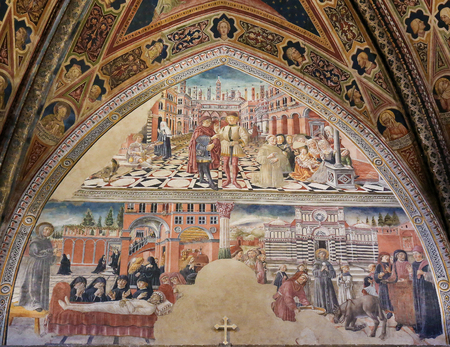
The Apostles’ Creed has been a central part of worship and declaring what individuals and congregations believe about the members of the Trinity since the early centuries of the Christian church. For centuries it was believed that after Pentecost and before the apostles dispersed in the Great Commission, they “mutually agreed upon a standard of their future preaching.” They were said to have developed this standard so that when they were separated, they would not unintentionally vary “in the statements which they should make to those whom they should invite to believe in Christ.” Yet it seems this origins tale for the Apostles’ Creed is just a legend.
The fourth century monk and historian, Rufinus Tryannius wrote a commentary on the Apostles’ Creed, probably around 307-309 AD. In his commentary Rufinus related the above origins story for the Creed which was widely believed in the Western Christian church until the 15th century. Each of the apostles, “filled with the Holy Ghost,” were said to have contributed several sentences to the one common summary, which later became known as the Apostles’ Creed. Rufinus said:
Our forefathers have handed down to us the tradition, that, after the Lord’s ascension, when, through the coming of the Holy Ghost, tongues of flame had settled upon each of the Apostles, that they might speak diverse languages, so that no race however foreign, no tongue however barbarous, might be inaccessible to them and beyond their reach, they were commanded by the Lord to go severally to the several nations to preach the word of God. Being on the eve therefore of departing from one another, they first mutually agreed upon a standard of their future preaching, lest haply, when separated, they might in any instance vary in the statements which they should make to those whom they should invite to believe in Christ. Being all therefore met together, and being filled with the Holy Ghost, they composed, as we have said, this brief formulary of their future preaching, each contributing his several sentence to one common summary: and they ordained that the rule thus framed should be given to those who believe.
The Apostles’ Creed itself was present and increasingly became an important summary of confession and belief in the life of the church from at least the time of Rufinus in the late 3rd and early 4th centuries. In his 5th century treatise on Christian piety, the Enchiridion, Augustine explained how the Apostles’ Creed was useful in teaching Christian doctrine and in refuting heresies. Along with the Lord’s Prayer, he thought the Creed was a succinct summary of the Christian doctrine and faith.
For you have the Creed and the Lord’s Prayer. What can be briefer to hear or to read? What easier to commit to memory? When, as the result of sin, the human race was groaning under a heavy load of misery, and was in urgent need of the divine compassion, one of the prophets, anticipating the time of God’s grace, declared: “And it shall come to pass, that whosoever shall call on the name of the Lord shall be delivered [Joel 2:32].” Hence the Lord’s Prayer. But the apostle, when, for the purpose of commending this very grace, he had quoted this prophetic testimony, immediately added: “How then shall they call on Him in whom they have not believed [Romans 10:14]?” Hence the Creed. In these two you have those three graces exemplified: faith believes, hope and love pray.
The above legend was an accepted part of the history of the church until the Council of Florence (1438-1445), which attempted a reunification of the Western and Eastern churches. At the beginning of the negotiations, the Western, Latin representatives invoked the Apostles’ Creed. In response, the Eastern Greek representatives said they did not possess and had never seen “this creed of the Apostles.” Moreover, as J.N.D. Kelly quoted Marcus Eugenicus in Early Christian Creeds, “If it had ever existed, the Book of Acts would have spoken of it in its description of the first apostolic synod at Jerusalem, to which you appeal.”
Once the question is squarely faced, the extreme unlikelihood of the Apostles having drafted an official summary of faith scarcely merits discussion. Since the Reformation the theory that they did has been quietly set aside as legendary by practically all scholars, the conservative-minded merely reserving the right to point out that the teaching of the formula known as the Apostles’ Creed reproduces authentically apostolic doctrine.
Kelly went on to say the legend is an example of the tendency of the early Church to “attribute the whole of its doctrinal, liturgical and hierarchical apparatus” to the Twelve Apostles, and through them to Christ himself. He said this could be acknowledged without prejudice to the question of whether 2nd century Church fathers were correct to claim their rule of faith was the same as the faith of the Apostles. If the question was “Did the apostolic Church possess an official, textually determined confession of faith” the answer is no, it did not. However, “creeds of a looser sort,” that lacked the fixed and official character of the later formularies—yet clearly foreshadowing them—were is use early on.
The early Church was a “believing, confessing, preaching Church.” If the Christians of the apostolic age had not seen themselves as possessing a body of distinctive, consciously held beliefs, why would they have separated from Judaism and begun their program of missionary expansion? “Everything goes to show that the infant communities looked upon themselves as the bearers of a unique story of redemption.” The New Testament is a collection of documents written “from faith to faith.”
The Gospels carefully elaborate certain dogmatic beliefs about Jesus, “which they seek to explain and justify.” The other documents “presuppose a background of faith shared by the author and those for whom he is writing.” For all their differences of nuance, the documents of the New Testament “comprise a body of literature which could only have sprung from a community with a strongly marked outlook of its own.”
In light of these considerations it is impossible to overlook the emphasis on the transmission of authoritative doctrine which is to be found everywhere in the New Testament. In the later strata the reference to an inherited corpus of teaching are clear enough. In Jude 3, for example, we read of “the faith once delivered to the saints”; later (verse 20) the author speaks of “your most holy faith”, again using the word in the sense of an accepted body of beliefs.
Further examples given by Kelly were from the Pastoral Epistles, including 1 Timothy 6:20; 2 Timothy 1:13; Titus 1:9. Hebrews advises its readers to “hold fast our confession;” without wavering (Hebrews 4:14, 10:23). In 2 Thessalonians 2:15 Paul exhorted his readers to “stand firm and hold to the traditions that you were taught by us, either our spoken word or our letter.” In Romans 6:17 Paul referred to the “standard of teaching to which you were committed.”
What we have before us, at any rate in rough outline, is the doctrinal deposit, at the pattern of sound words, which was expounded in the apostolic church since its inauguration and which constituted its distinctive message.
The story that the Twelve met and composed an “Apostles’ Creed” is a pious fiction. But by the 2nd century there was a “rule of faith” or a “canon of truth” believed and taught by the Church, and inherited from the Apostles. It just wasn’t an official, textually set confession of faith or a creed, as with the Apostles’ Creed and others that followed. The content of that rule, in all it essentials, was foreshadowed by the “pattern of teaching” accepted in the apostolic Church. Its essentials were prototypically contained in the New Testament. From the end of the first century to the middle of the third century, there were only creeds in this elastic, nontechnical sense of the term. “That the Church in the apostolic age possessed a creed in the broad sense of a recognized body of teaching may be accepted as demonstrated fact.”
For more on the early creeds and heresies of the Christian church, see the link: “Early Creeds.”





